The Dapple Dachshund is a particular variety of the Dachshund breed with an unusual genetic feature. A regular Dachshund, affectionately known as the Doxie, is a single color. However, Dapple Dachshunds have the merle gene, resulting in a coat that has a base color with splashes of a different color, creating a dappled pattern.
Dapple Dachshunds are popular due to their loyal character and spunky personalities. These dogs are ideal for people with plenty of time to devote to a pet because this breed loves attention and human interaction. With a lifespan of up to 16 years, a Dapple Dachshund makes a perfect long-term pet for a devoted and loving dog owner.
The breed’s small size makes it suitable for apartment living, provided the owner can give the dog regular exercise. Because the Dapple Dachshund is prone to painful back problems, a household with small children isn’t the best home for this type of dog. The dog may respond aggressively to rough handling, out of fear of being hurt.
TABLE OF CONTENTS
- Dapple Dachshund Quick Summary
- Physical Characteristics of the Dapple Dachshund
- Dapple Dachshund Origins
- Dapple Dachshund Personality and Temperament
- Taking Care of a Dapple Dachshund Dog
- Dapple Dachshund Health Issues
- Should You Get a Dapple Dachshund?
- FAQs
- A Dapple Dachshund is More Than Just a Pretty Coat
Dapple Dachshund Quick Summary
Physical Characteristics of the Dapple Dachshund
The Dapple Dachshund is a small dog with an unusual coat. The dog’s coat usually has spots or patches of one color appearing over a base of another color, creating a dapple effect. Occasionally there is only one small spot of a different color somewhere on the dog’s body, but this dog would also be considered a Dapple Dachshund. The dogs have either blue eyes or dark brown eyes.
Height and Weight
Dapple Dachshunds are small dogs with an average height of 8 to 9 inches. The breed has short, stubby legs with a long body and usually weighs between 16 and 32 pounds. These dogs tend to gain weight easily and often suffer from obesity. The extra weight puts a strain on the dog’s back, often causing spinal problems.
Dachshund puppies grow quickly, reaching their full adult length and height at 12 months, but the dogs often continue to gain weight and fill out for a few months longer.
The miniature Dapple Dachshund is 5 to 6 inches tall with a weight of 11 pounds or less.
Coat
The Dapple Dachshund comes in a variety of colors. The coat usually has either a brown or black base with a dappled pattern consisting of splashes of another color all over. There may also be patches of white, especially under the chin and on the chest.
The presence of the merle gene causes the dapple effect and includes variations like black and tan, chocolate and tan, black and cream, chocolate and cream, or reddish patches. There are also some rare varieties of Dapple Dachshunds with blue-black or silvery patches on their coat.
The texture and length of the fur on the coat are either short and smooth with a glossy sheen, long and silky, or wire-haired and coarse.
Eyes
Dapple Dachshunds usually have either brown or blue eyes, and occasionally one blue eye and one brown eye. Blue eyes are more common in Dapple Dachshunds with white patches.
The breed sometimes suffers from a rare eye condition called microphthalmia, in which the eyes are underdeveloped and abnormally small. Occasionally only one eye is affected. This condition causes severe vision problems and often leaves the dog totally blind.
In very rare instances a Dapple Dachshund affected by microphthalmia has only one eye.
Tail
The Dapple Dachshund’s tail is usually 9 to 10 inches long and directly in line with the backbone. The tail doesn’t have kinks but curves up at the tip.
Ears
Dachshunds are known for their long, soft, and silky ears. The Dapple Dachshund also has these beautiful ears. The breed’s long ears hang down loosely, preventing dirt, gravel, and other foreign objects from entering the ear canal and causing problems when the dogs dig in the earth.
Dapple Dachshund Origins
The standard Dachshund originated in Germany in the 16th Century — where badger-hunting was a popular hobby, and this dog was bred to hunt and dig for badgers. The word Dachshund means badger dog, and this breed gets its name from the German words dach, meaning badger, and hund, meaning dog.
Although the Dachshund was first introduced in the 1500s, the breed was only officially recognized by the AKC (American Kennel Club) in 1885.
Emergence of the Dachshund Varieties
As the breed developed over the centuries, Dachshunds were bred in three varieties: the standard, miniature, and rabbit. Alongside this size variation, their coats also diversified into smooth, long-haired Dachshunds and wire-haired Dachshunds each suited to different terrain and weather conditions.
Dapple Pattern: A Genetic Trait
The dapple (or merle) pattern in Dachshunds is a result of a specific genetic trait. This pattern is characterized by lighter-colored areas contrasting with the darker base color of the coat. It’s important to note that the dapple pattern is not a separate breed but rather a coat color variation within the Dachshund breed.
This dapple coloring is caused by a particular gene known as the merle gene. It affects the pigmentation of the coat, leading to the distinct mottled or patchy coloring. This is a dominant gene, meaning that only one parent needs to have the gene for it to be passed on to the offspring.
What’s a Double Dapple Dachshund?
Double Dapple Dachshund puppies are the offspring of two Dapple Dachshund parents that both carry the merle gene. These Dachshunds usually have large patches of white mixed with other colors.
Reputable breeders don’t encourage breeding Double Dapple Dachshund puppies, making this variety extremely rare. That’s because the double merle gene may cause severe genetic defects affecting the eyes and ears, sometimes resulting in total blindness and/or deafness.
Modern Day Dapple Dachshunds
Despite these concerns, the Dapple Dachshund has grown in popularity, celebrated for its distinctive and attractive coat. Major kennel clubs recognize this breed in various color patterns, including single dapple, double dapple, brindle, and piebald.
This brave, curious, and lively breed with a strong hunting instinct inherited from its ancestors is a popular pet, show dog, and, in some cases, hunting companion.
Dapple Dachshund Personality and Temperament
Dapple Dachshunds are loyal dogs with a friendly temperament. These dogs enjoy socializing with other dogs and do well in multiple-dog households if introduced to fellow pups at an early age.
Because these dogs were originally bred as hunting dogs, chasing after smaller creatures is instinctive. Hence, these dogs don’t do well in households with birds, hamsters, and other small animals, which they might chase and injure.
Dapple Dachshunds aren’t usually aggressive, despite their feisty nature. However, because the dogs often suffer from severe, painful back problems, Dapple Dachshunds sometimes respond aggressively to rough handling. Because of this behavior, the breed isn’t recommended for families with small children who may be rough with dogs. The following are other unmissable traits:
Courageous and Brave
Dapple Dachshunds are surprisingly brave and bold, a trait stemming from their hunting heritage. Despite their small stature, they exhibit a fearless disposition and often show readiness to face challenges much larger than themselves.
Affectionate
Since these dogs are incredibly loyal to their owner, they often form strong bonds with a particular family member. Their affectionate nature makes them excellent companions, thriving on interaction and attention from their human family.
Intelligent and Curious
Known for their intelligence and curiosity, Dapple Dachshunds have a keen sense of smell and enjoy exploring new environments. This intelligence means they are trainable, but their independent streak might require patience and consistency.
Playful and Lively
Dapple Dachshunds have a playful and lively character. They enjoy games and can be quite entertaining with their antics. However, it’s important to monitor their play, especially with children, to ensure gentle handling.
Stubborn and Independent
A hallmark trait of the Dachshund breed is their stubbornness. They possess a strong independent streak, making training a challenge at times. They often respond best to positive reinforcement techniques.
Alert and Vocal
These dogs are alert and can be quite vocal, making good watchdogs as they are likely to alert their owners to any unusual activity or strangers’ presence.
Sensitive
Dapple Dachshunds can be sensitive to their environment and the mood of their owners. They generally do not like being alone for long periods and can suffer from separation anxiety.
Adaptable
Dapple Dachshunds are adaptable to various living situations, including apartments, as long as they receive regular exercise and mental stimulation. They have a lot of energy for their size but can adapt well to different living conditions.
Taking Care of a Dapple Dachshund Dog
Feeding
The Dapple Dachshund is an easy dog to care for and doesn’t have any special needs. Food and water, daily exercise, love and attention, regular checkups and vaccines at the vet, and regular grooming keep the dogs fit and healthy. As long as its basic needs are met, the breed can be expected to live a long and healthy life with a lifespan of up to 16 years. Here’s how you can meet its dietary needs.
Nutritional Needs
Their diet should include a good balance of proteins, carbohydrates, fats, vitamins, and minerals. Proteins are crucial for muscle development and maintenance, while fats provide energy and support skin and coat health. Carbohydrates are important for energy, but should be given in moderation to avoid weight gain, a common issue in Dachshunds. If you have pregnant Dapple Dachshunds, feed here specialized nutritious food for pregnant dogs to support their health and the development of their puppies.
It’s also essential to include a range of vitamins and minerals to support overall health. High-quality commercial dog foods usually provide a balanced diet, but it’s always a good idea to check the ingredients and ensure they meet your dog’s specific needs.
Feeding Schedule
Consistency is key when feeding a Dapple Dachshund. They typically do well on two meals a day – one in the morning and one in the evening. Puppies, however, require more frequent feeding, usually three to four times a day. Feeding your Dapple Dachshund one cup of good-quality dry kibble per day promotes a healthy digestive system, keeps the coat in prime condition, and preserves healthy teeth.
It’s important to establish and stick to a regular feeding schedule to help regulate their digestion and prevent overeating. Avoid free feeding (leaving food out all day) as this can lead to obesity, particularly in a breed prone to weight issues.
Portion Control
Portion control is crucial for Dapple Dachshunds due to their propensity for obesity. The appropriate portion size depends on their age, size, activity level, and the type of food being fed. Always refer to the feeding guide on your dog food’s packaging as a starting point and adjust as necessary. Using a measuring cup for kibble is a good practice. Regularly monitoring their weight and body condition is important, and adjustments to their diet should be made if they start to gain or lose too much weight.
Treats and Snacks
While treats and snacks can be used effectively for training and bonding, they should be given in moderation to Dapple Dachshunds. Treats should not make up more than 10% of their daily caloric intake. Opt for healthy options like small pieces of lean meat, vegetables, or specially formulated dog treats. Avoid human food as treats, especially those high in fat and sugar, as well as foods toxic to dogs like chocolate, grapes, and onions.
Special Diet Considerations
Some Dapple Dachshunds may have specific dietary needs due to health issues like allergies, sensitivities, or medical conditions like diabetes. In such cases, a special diet may be necessary. Hypoallergenic or grain-free diets can benefit dogs with allergies or sensitivities. For dogs with medical conditions, consult a veterinarian to formulate a diet that meets their specific needs. It’s also important to be aware of their tendency for spinal issues and maintain a diet that supports healthy weight management to reduce stress on their spine.
Fresh Water
Access to fresh, clean water is essential for Dapple Dachshunds, as it is for all dogs. Ensure that your dog has constant access to water, and change it frequently to keep it clean and fresh. Hydration is important for overall health and aids in digestion and nutrient absorption. During hot weather or after exercise, they may need more water, so it’s important to monitor their water intake and encourage them to drink if needed.
Grooming Needs
As a lifelong dog enthusiast, I understand the importance of proper grooming for maintaining a dog’s health and well-being. When it comes to Dapple Dachshunds, their unique coat and body structure require specific grooming practices. In this section, I’ll share essential guidelines for bathing, nail care, ear care, and dental hygiene, tailored specifically for the needs of a Dapple Dachshund.
Coat Care
The three coat types have different grooming needs.
- Smooth-coated Dapple Dachshund needs little grooming and can usually be wiped clean with a damp cloth or hound glove
- Long-haired Dapple Dachshund should be brushed weekly to prevent the coat from becoming matted.
- Wirehaired Dapple Dachshund needs weekly brushing and regular plucking of old, stray hairs. The beard should be trimmed every 3 months
Bathing
Dapple Dachshunds require regular baths, but not too frequently as over-bathing can strip their coat of natural oils, leading to dry skin. Depending on their lifestyle and coat type, bathing every three months is usually sufficient. For Dachshunds with longer or wire-haired coats, more frequent bathing may be necessary. Always use a dog-specific shampoo that’s gentle on their skin.
During the bath, check for any skin issues like bumps, cuts, or parasites. Ensure a thorough rinse to remove all shampoo residues and dry them completely after bathing, paying special attention to their ears and under the folds of the skin.
Nail Care
Regular nail trimming is essential for Dapple Dachshunds to prevent discomfort and mobility issues. Their nails should be trimmed every 3-4 weeks. If you can hear their nails clicking on the floor, it’s time for a trim. Use a suitable nail clipper or grinder for dogs and be cautious not to cut into the quick, as it can be painful and may cause bleeding. If you’re unsure about doing it yourself, a professional groomer or vet can assist. Regular walks on hard surfaces can also help naturally wear down their nails.
Ear Care
Ear care is crucial for Dapple Dachshunds, especially for those with floppy ears. Their ear structure makes them prone to ear infections and the buildup of wax and debris. Check their ears weekly for redness, bad odor, or excessive dirt, which could indicate an infection. Clean their ears gently using a dog-specific ear cleaner and a cotton ball or soft cloth. Avoid inserting anything into the ear canal. If you notice any signs of an infection or excessive wax buildup, consult a veterinarian.
Dental Hygiene
Dental hygiene is an important aspect of grooming for Dapple Dachshunds. Regular teeth brushing is recommended to prevent dental issues such as tartar buildup, gum disease, and tooth decay. Ideally, brush their teeth daily using a dog-specific toothbrush and toothpaste. Introduce dental care early in their life to make it a routine part of their grooming. In addition to brushing, dental chews, and toys can help maintain dental health. Regular dental check-ups with a vet are also important to ensure their oral health is maintained.
Training and Exercise
Dapple Dachshunds are highly intelligent, but extremely stubborn dogs. This combination makes them difficult to train and training should be done by an experienced dog handler. Here are a few tips on how to train your Dapple Dachshund.
Training
Starting young is crucial for successful training, as training that begins in early puppyhood tends to have the highest success rate. It’s important to keep training sessions short to prevent your dog from becoming overtired or bored, which can hinder their learning process. Additionally, sticking to a regular schedule helps the dog learn what to expect and when, fostering a more structured and effective training environment.
Dapple Dachshunds are sensitive dogs, so it’s important to avoid raising your voice or speaking harshly. Instead, maintain a firm and consistent approach in guiding them. Encouraging cooperation is best achieved through lots of praise, positive reinforcement, and rewards for obedience. This approach not only promotes good behavior but also strengthens the bond between you and your Dapple Dachshund.
Exercise
Dapple Dachshunds need regular exercise to keep fit and healthy and avoid obesity. Walk your dog three times a day for at least 30 minutes per walk. Keep the dog on a leash at all times when walking because it will instinctively want to chase after birds, cats, rodents, and other dogs.
Because Dapple Dachshunds have a long back, they are prone to back problems. Don’t encourage the dog to jump on and off beds or furniture. The jumping and landing movement jars the back and can damage the spinal cord over time.
Mental Stimulation
The Dapple Dachshund is an anxious dog that needs a lot of attention and stimulation to keep anxiety under control. This breed, historically, is used to living in packs and doesn’t like being left alone for long periods.
Play with your dog and shower it with love and attention when you can. These dogs are highly affectionate and enjoy one-on-one time with their humans. Dapple Dachshunds have a loud, high-pitched bark that stems from their hunting and burrowing origins. Owners can prevent barking by providing plenty of mental exercise and stimulation.
The breed can be left at home for brief periods. However, make sure your dog has lots of doggy toys to keep it amused so that the dog doesn’t get bored and bark, or destroy your possessions.
Dapple Dachshund Health Issues
Dapple Dachshunds are generally healthy, but these dogs do have certain common health issues. According to the Dachshund Breed Council, some of these health problems are more common in the Double Dapple Dachshund, because of the double merle gene.
Ear Infections
Dapple Dachshunds can get ear infections if the ears aren’t kept clean. Clean the ears weekly by wiping the inside of the ear with a clean, damp cloth. In addition to regular ear cleaning, feeding them a diet tailored for dogs with ear infections, such as specialized hypoallergenic or low-inflammatory foods, can help manage their condition. Remember, in double dapples, there is a possibility of partial hearing loss or complete deafness.
Eyes Problems
The merle gene that causes the dapple pattern on the coat is also responsible for this breed’s frequent eye problems. If your Dapple Dachshund suffers from poor vision, ensure that the dog’s surroundings are safe. Double dapples are more likely to have microphthalmia and are occasionally born with only one eye
Back Disease
The Dapple Dachshund’s elongated back is prone to IVDD (intervertebral disc disease), a painful back condition caused by compressed discs. This problem is exacerbated by obesity. Keeping the dog’s weight under control and limiting jarring movements can prevent back problems from developing
Skin Allergies
The merle gene is also associated with skin cancer. Many Dapple Dachshunds suffer from skin allergies, causing severe itching. Bathe your dog monthly using good-quality, hypo-allergenic dog shampoo to prevent this, and treat any outbreaks immediately with skin preparations from your vet.
Cushing’s Disease
Dapple Dachshunds are also prone to Cushing’s disease, caused by excessive cortisol production. Symptoms include increased thirst, urination, appetite, and a pot-bellied appearance. A balanced diet tailored to the nutritional needs of dogs with Cushing’s disease can help manage symptoms. This may include low-fat foods, lean protein sources, complex carbohydrates, limited sugars, omega-3 fatty acids, and adequate hydration. Regular check-ups are crucial for early detection and management.
Should You Get a Dapple Dachshund?
The Dapple Dachshund is a great dog with a vibrant personality and makes a wonderful pet. However, this breed has certain special considerations and may not be suitable for some people or lifestyles.
When buying a Dapple Dachshund puppy, checking out the parents is important. Avoid puppies where parents have obvious problems like an extra-long back or very small eyes. The offspring of these dogs often inherits the parents’ genetic defects.
Dapple Dachshunds are Suitable for:
Dapple Dachshunds make good apartment dogs, because of the breed’s small size. These dogs do well with apartment living if they’re given regular exercise and walked at least three times a day.
Active, energetic owners who enjoy a feisty dog make good owners for a Dapple Dachshund. These dogs are highly affectionate and reward a devoted owner with great loyalty.
Because these dogs sometimes have particular health issues, their owners should be able to afford possible unexpected medical expenses.
Dapple Dachshunds are NOT Suitable for:
Because Dapple Dachshunds can be stubborn and challenging, they aren’t suitable for inexperienced first-time dog owners. These dogs need an owner who has spent time with dogs and knows how to handle stubbornness.
This breed isn’t the ideal dog for a family with young children. Because this breed is prone to back problems, it needs careful handling and is often alert and on the defensive, in case it gets hurt. A Dapple Dachshund that’s handled roughly by a small child may snap at and hurt the child.
Dapple Dachshunds are known to be demanding of attention and need an owner who has time and energy to devote to their dog daily. A frail or elderly owner who isn’t able to walk a dog regularly shouldn’t consider a Dachshund because these dogs need daily exercise outdoors.
FAQs
How much is a Dapple Dachshund puppy?
Dapple Dachshund puppies cost between $400 and $1,500, depending on the breeder and the area. Expect to pay more for a pup from a reputable breeder because a good breeder needs to recoup the high costs of things like vaccinations and health checks. Reputable breeders limit the number of litters from each set of parents to prevent genetic disorders caused by inbreeding, so these puppies cost more.
Double Dapple Dachshund puppies are often touted as being extremely rare and, therefore, are more expensive than single Dapple Dachshunds, selling for up to $2,000. This is misleading because breeding Double Dapple Dachshunds is considered to be unethical due to health problems. These dogs should be avoided.
Dapple Dachshunds are fairly rare and are therefore more expensive than other Dachshund varieties. Hence, adults can sometimes be bought at a lower price, or adopted from a shelter for $250 or less.
How much does it cost to raise a Dapple Dachshund?
Budget $1,000 to $1,500 for starting-out expenses, vet bills, vaccinations, and food in the first year of a Dapple Dachshund’s life. After this initial cost, expect to pay about $1,000 per year for food, grooming, and general vet expenses for a healthy dog.
When budgeting for raising a Dapple Dachshund, consider the dog’s 12- to 16-year life expectancy and budget accordingly. Remember that the dog may become ill and need more expensive medical care with age.
Are Dapple Dachshunds different in temperament from regular Dachshunds?
Dapple Dachshunds generally share the same temperament as standard Dachshunds. They are known for being playful, brave, and a bit stubborn. However, like all dogs, individual temperaments can vary. Their unique coat pattern is the main feature that sets them apart from other Dachshunds.
How do you care for a Dapple Dachshund’s coat?
Caring for a Dapple Dachshund’s coat depends on the type (smooth, long-haired, or wire-haired). Regular brushing is important to keep their coat healthy and to reduce shedding. Smooth coats require less frequent grooming, while long-haired and wire-haired may need more regular brushing and occasional trimming.
What health issues should I be aware of in Dapple Dachshunds?
Dapple Dachshunds, like all Dachshunds, are prone to certain health issues, including intervertebral disc disease (IVDD) due to their long spines. They can also be predisposed to genetic conditions like deafness and eye problems, especially in Double Dapple Dachshunds. Regular veterinary check-ups and maintaining a healthy weight are important for their overall well-being.
How often should I exercise my Dapple Dachshund?
Dapple Dachshunds require moderate exercise to maintain their health and happiness. Daily walks and playtime are essential, but the intensity should be moderated to avoid strain on their backs. Activities that encourage them to move and explore without excessive jumping or strenuous activities are ideal.
Is it difficult to train a Dapple Dachshund?
Dapple Dachshunds can be a bit stubborn, making training a challenge at times. However, they are also intelligent and respond well to positive reinforcement methods like treats and praise. Consistency and patience are key in training. Early socialization and obedience training can help in developing a well-behaved dog.
A Dapple Dachshund is More Than Just a Pretty Coat
These dogs are truly unique. Their distinct coat patterns, with splotches of color against a darker base, set them apart visually from regular Dachshunds. But beyond their striking appearance, these dogs possess a spirited and affectionate personality that endears them to many. Their courage, intelligence, and playfulness, coupled with a touch of stubbornness, make them both challenging and rewarding companions.
What differentiates the Dapple Dachshund from standard Dachshunds, apart from their coat, is largely a matter of aesthetics. However, it’s important to be aware of the potential health issues unique to this variant, particularly when it comes to breeding practices.
Choosing to bring a Dapple Dachshund into your life means embracing both their beauty and their spirited nature. While they require dedicated training, socialization, and care, the joy and companionship they offer in return make the journey incredibly worthwhile. Their loyalty and unique charm make them not just pets, but cherished members of the family.
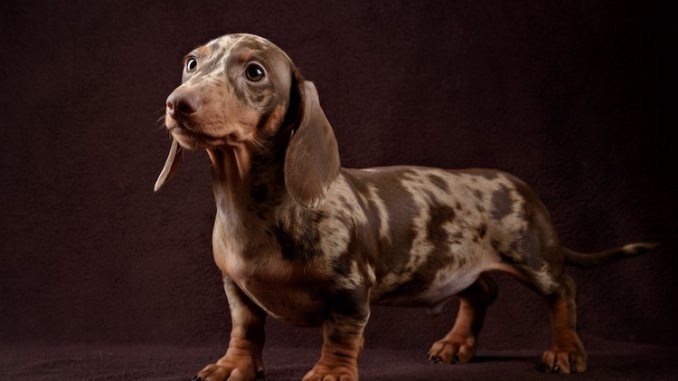
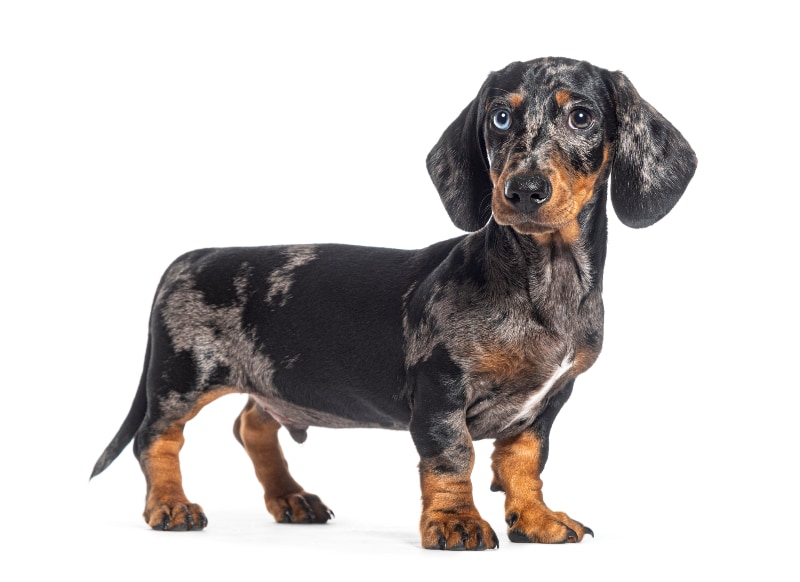

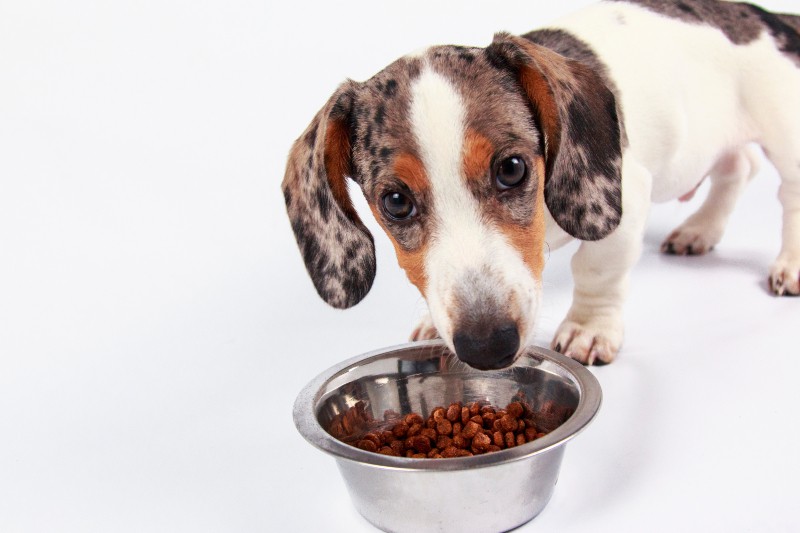
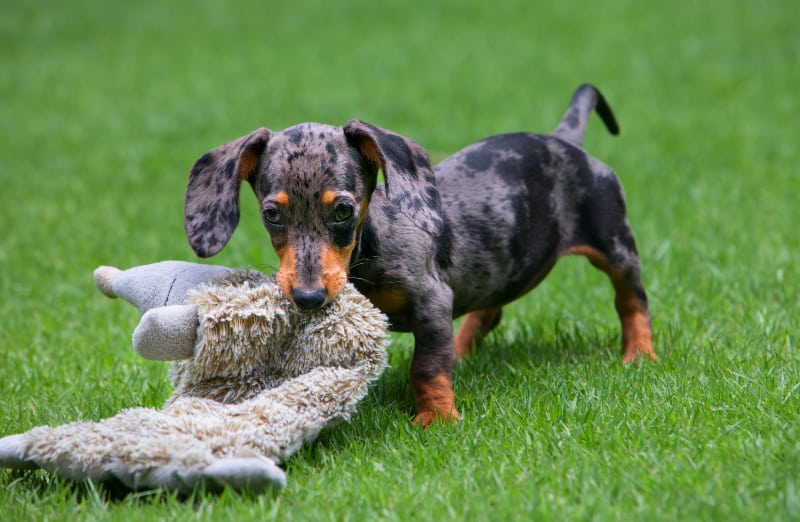
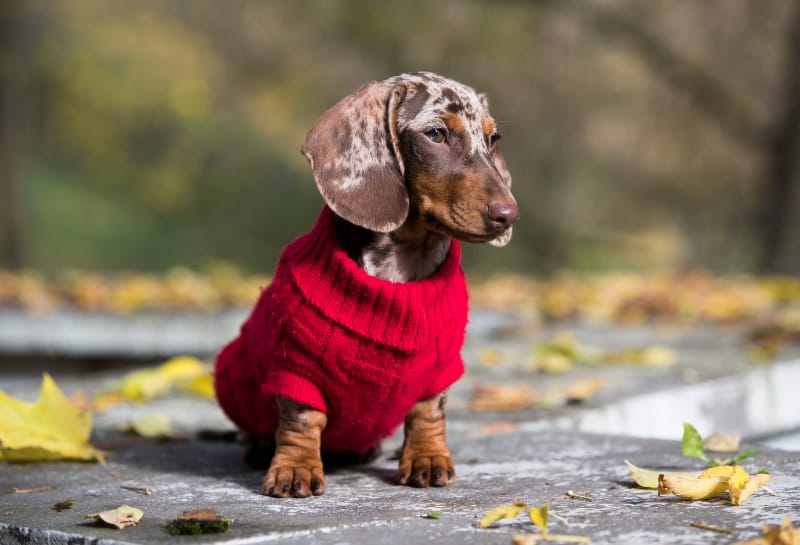

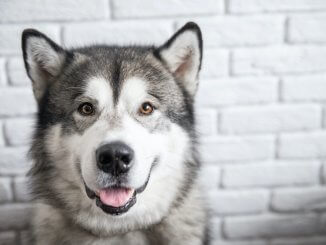
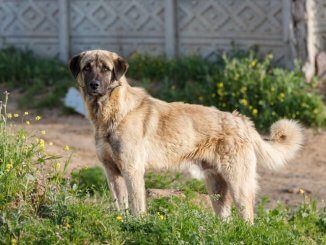
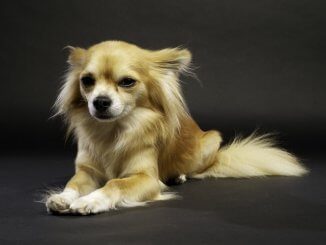
Great article thank you super helpful.
We bought our 1st dappled-doxie come to find out she’s double dapple partially blind and deaf the breeder didn’t tell us. Sad someone would do that to her. She’s adjusting well she is precious loving and full of energy. No breeder should do this to any dog she’s had challenges from her disabilities but hasn’t stopped her. Make sure when you get one she’s not double dappled unless your willing to deal with health problems
Thank you for all that information. I want a dapple, I have raised doxies in the past, a long time ago and had a dapple show up in a litter. She was not only adorable but very easy to train. Have been a Yorkie breeder for 43 years and no longer breed.
I read where you found your dapple easy to train. Someone wants to give me a puppy in 3 weeks. This is encouraging that I can train the pup to use puppy pads and crate rest. I also have 3 young grandkids that visits.
We have a rescued dapple and it took us a long time for him to acclimate. Now he just wants me to touch him all the time, my husband says he is in love with me. Thank You for your article, it helps me to understand him more, he is awesome.